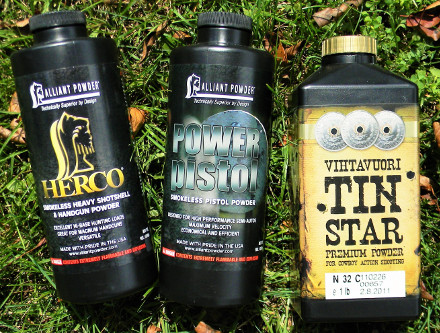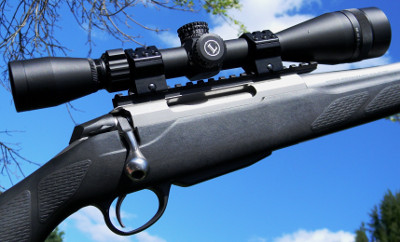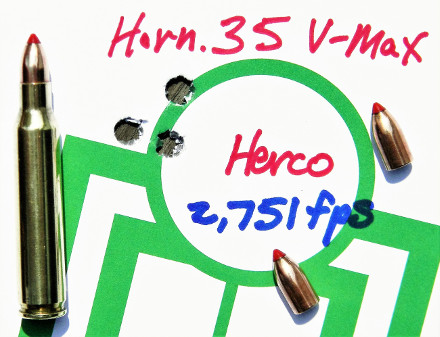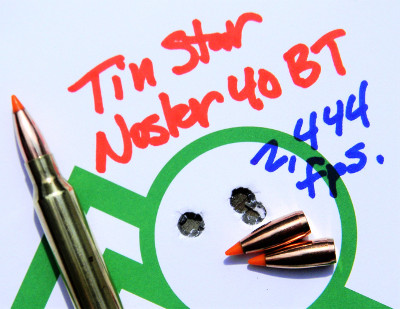
In this third article of the series, I’ve paired the three successful handgun and shotgun powders- Herco, Power Pistol, and Tin Star- covered in Part 2, with six popular varminting bullets including three lead-free versions for those areas now prohibiting traditional lead cored bullets. Again, my new .223 Tikka T3 Lite sporter continued to amaze me with so many sub-half inch groups at 100 yards.
Personally, at times I found it hard to believe how it consistently shot so well, and the number of groups it amassed, well under a half-inch, and many at or below 3/8”. But the target photos prove that many combinations of moderate charges and the six tested bullets, rewarded me again and again with clover leaf groups at 100 yards.
A “bad” group might have two in one hole, with a 3rd a half inch out. I feel what this really represents is me “pulling” one of the shots, as when you have a combination that is shooting so well, any shooter error shows up with a shot slightly out of the group.
Remember that the first group ever out of this new rifle measured less than one-eighth inch! This is truly outstanding for a production rifle having only a sporter weight barrel.
The bullets tested this time included two .22 Hornet bullets: the 30 grain Barnes lead-free Varmint Grenade and the 35 grain tipped lead cored V-Max. Also lead-free were the 35 grain Hornady NTX, and the 36 grain Barnes Varmint Grenade. Finally, two traditional 40 grain lead cored tipped bullets, the Hornady V-Max and Nosler’s Ballistic Tip.
Blue Dot worked so well for these loads because it was a very bulky flake powder, which burned cleanly while producing useable “varmint” speeds with great accuracy. Because of its great bulk, when used in loads that resulted in 63 ~ 78% fill rates, double charging was not possible. A double charge would spill out all over your bench, alerting you to the error.
Scanning over burn rate charts and running various powders through the QuickLOAD ballistic program’s incremental stepping function, some bulky, relatively faster burning handgun and shotgun powders emerged as possible candidates. From Alliant, I would be testing two flake powders- Herco and Power Pistol; and Vihtavuori’s Tin Star (N32C), which is an extruded powder specifically designed for high-bulk to produce lower speeds...
with nearly casefulls under lead bullets in cowboy handgun rounds.
So armed with these three powders, I sat down with QuickLOAD, and proceeded to run the numbers, again limiting top pressures to 45,000 PSI or less while keeping the fill rate to 55% or above. A Leupold MK-AR 6-18x40mm scope was used on my stainless Tikka T3 Lite (NOT the heavy-barreled varmint model) having a 22.4” barrel, measuring .625” at the muzzle.
I used a Hornady O.A.L. modified case and tool to determine the loaded length of the bullets and seated each one to allow for 0.010” jump to the rifling. The much shorter and blunter noses of the 30 grain Barnes and 35 grain Hornady V-Max- both meant for the .22 Hornet resulted in shorter than typical overall lengths. But both so loaded rounds fed smoothly from the Tikka magazine. Conversely, the very slender nose of the 40 grain Nosler Ballistic Tip resulted in a longer 2.305” length, still short of the magazine’s allowable maximum of 2.310”.

Low Barrel Heating,Low Recoil Loads
For well over 20 years, I’ve been creating MELs- or Moderate, Effective Loads- for all of my centerfire hunting rifles. Instead of a casefull of slow burning powders to achieve 3,000+ fps, I load 35 to 45 grains of medium to medium fast burning rifle powders such as H4198, H4895 or H322, resulting in around 2,700 fps loads. They work great for practice or even hunting out to 200 yards or more, and are excellent for starting young or beginning shooters out with traditional hunting calibers, with loads that produce around half the recoil of full-power ammunition.
So the concept of not filling a case up all the way with traditional powders is very comfortable for me. All loads used once-fired Lake City military 5.56 brass and would also be safe in any .223 commercial brass. Both Remington and Winchester small rifle primers were used with no noticeable differences. Velocities were recorded using a Competitive Edge DynamicsCED M2 chronograph.
So let’s see how conventional varmint bullets worked with the three proven powder alternates to the original Blue...
Dot Gopher Loads…

AlliantHERCO_
Herco is a large diameter flake powder very similar looking to Blue Dot, but almost black in color. With the Barnes 30 grain Varmint Grenade, charges of 10.0 ~ 11.9 grains delivered just over 3,000, to almost 3,360 fps, with groups running from 0.33 ~ 0.63” for 3 shot averages at 100 yards. The most accurate load was with 10.0 grains of Herco, for 3,015 fps, and an amazing average of only 0.33”. Clover leafs were the norm with this load in my Tikka. All three loads averaged only 0.46”. The case fill percentage of Herco with this bullet ran between 64 and 76%.
Barnes 36 grain lead-free Varmint Grenade duplicated .22 Hornet speeds, running from 2,626 to almost 2,940 fps. The loads all averaged 0.71” for 3-shots. Note however, that the two other powders tested produced much smaller groups with this Barnes.
The 40 grain Hornady V-Max averaged just over a half inch for all charges tested of Herco- 0.52”, to be exact. The most accurate load delivered 0.42” groups, powered by 9.4 grains, good for 2,611 fps, while the top charge of 11.2 grains broke 2,900 with 0.58” averages.
Nosler’s sleek 40 grain Ballistic Tip shot in the “fours” with either 10.6 or 11.3 grains of Herco, at speeds of over 2,700 to 2,800 fps. These are typical .22 Hornet velocities but with much better accuracy. And the higher BC of this bullet better carries the speed and energy downrange.
Alliant POWER PISTOL-
Power Pistol is also a flake powder, but is maybe half the diameter of Herco or Blue Dot, and light silver/gray in color. Due to its smaller size, it meters very well. Case fill ratios ran between 55 and 64% for all listed loads.
Probably my pick, propellant-wise, for three of the four bullets under 40 grains, as with those nine different combinations, Power Pistol grouped between 0.41 and 0.44 inches, for 3-shot averages. This is truly exceptional performance! Speed ranged from just under 3,000 to over 3,600 fps, making for excellent performance in the field. 11.2 to 12.9 grains drove the 30 grain Barnes Varmint...
Grenade to between 3,330 and 3,660 fps, averaging 0.41 for all charges. The most accurate load shot into only 0.33, at 3,510, under only 12.2 grains of Power Pistol. This would be an excellent low recoil, low barrel heating load for situations demanding high-volume shooting.
Three charges under Hornady’s 35 grain V-Max averaged 0.44, with the most accurate loads being 10.9 grains, for 3,069 fps and an amazing 0.38” 3-shot group average. Note that you will get six-hundred and forty two rounds (642) with this charge from a pound of powder!!! That works out to less than 5 cents per shot for powder costs- perfect for high-volume shooting.
While economical for practice, it would also do quite nicely out to 200 yards for pests. Their 35 grain lead-free NTX averaged 0.61” groups with speeds running from just over 3,000 to 3,340 fps, on 10.5 to 12.2 grains of Power Pistol.
The 36 grain Barnes lead-free Varmint Grenade was a doozy. The first two loads of 10.7 and 11.5 grains producing averages of only 0.32 and 0.37” for 3-shots. Speeds respectively were almost 3,000 to just over 3,100 fps, great velocity for pests to 200+ yards.
Finally, two 40 grain lead-cored, plastic tipped, boat tail bullets were tested- the Hornady V-Max and the Nosler Ballistic Tip. With the Hornady, the beginning load of 10.8 grains gave almost 3,000 fps, and 0.52” group averages. The top load of 12.1 grains of Power Pistol delivered just short of 3,200, with 0.64” averages.

11.0 grains of Power Pistol pushed the 40 grain Nosler Ballistic Tip to 2,963 fps, and 3-shot averages of only 0.39”. The rifle goes “POP!”, while hole after hole appears next to each other- or touching- 100 yards distant. At times, it’s hard to believe, but it kept happening again and again. The top load of 12.2 gave over 3,100, and averaged just over a half-inch.
Vihtavuori TIN STAR (N32C)-
Did you ever go to pick up a gallon of milk which you think is full, only to have your arm shoot up when you then realize it was almost empty? Tin Star gives me the same first impression. While the .223 case can hold 28 grains or more of...
a dense ball powder, a case full of Tin Star (
NOT a recommended load!) only weighs just over 12 grains! A very light weight extruded “log” powder, it was designed specifically to provide mild lead bullet loads for cowboy action shooters, while almost filling up the case to minimize airspace. In a .223, this bulky extruded powder worked well with 73 to 90% fill ratio loads.
In a .223, this bulky extruded powder worked well with 73 to 90% fill ratio loads.
The most accurate load paring- Tin Star with the 30 grain Barnes Varmint Grenade- was 11.2 grains, good for 2,911 fps and 0.37” groups averages. 10.7 grains also shot well at 0.41”… and at speeds just over 2,830. Under the 35 Grain Hornady V-Max, 10.2 grains shot best at 0.49, and delivered 2,664 fps.
With their lead-free NTX of the same weight, only 8.9 grains of Tin Star gave 2,377 fps, and tiny 0.35” 3-shot averages. This load handily beats the .22 Mag, can be loaded for comparable or lower costs, and you’ll never run out and have to try and find loaded ammo at a gun store. The top charge of 10.7 grains was over 300 fps faster while producing 0.56” groups.
Barnes 36 grain Varmint Grenade consistently shot just over a half-inch when loaded over 9.6 to 10.8 grains
Barnes 36 grain Varmint Grenade consistently shot just over a half-inch when loaded over 9.6 to 10.8 grains. Speeds ran from 2,400 to 2,600 fps, approaching Hornet velocities. The best load with the 40 grain Hornady V-Max was 10.8 grains, good for almost 2,600 and 0.40” averages. The lightest load of 9.6 grains bettered a .22 Mag, at 2,300 fps while shooting just over a half-inch. All three loads with this bullet resulted in a happy average of only 0.50” for 3-shot groups.
Testing the Nosler 40 grain Ballistic Tips with Tin Star produced an average of 0.57”, while over charges ranging from 9.5 to 10.9 gains. Speeds were almost 2,350 to over 2,530 fps. Due to its high bulk, the case fill rate ranged from 76 to 87%. A dozen or more shots fired, and the barrel was more than warm, but nowhere near hot- perfect for practice and plinking.
...
Summary
Click to LOAD DATA SHEET
Producing only half to a third of normal recoil, your gun goes “pop” as bullet after bullet usually land within a half-inch or less of each other, most often touching. Then you look at your chronograph and can’t believe you’re getting 3,000 to over 3,600 fps. And after over a dozen shots, your sporter barrel is only warm, while that many full-power loads would have left it too hot to touch. So if you pace yourself to a reasonable rate of fire, in a prairie dog town, you can just keep shooting and shooting without having to stop.
Producing only half to a third of normal recoil, your gun goes “pop” as bullet after bullet usually land within a half-inch or less of each other, most often touching.
The Blue Dot alternatives of Herco, Power Pistol and Tin Star, have also proven to be very compatible with many of the lighter popular .224 bullets and would be great for practice or pests out to 200+ yards with the faster loads. The lower recoil and reduced muzzle blast makes them fun to shoot again and again. And importantly, with almost zero muzzle rise at each shot, you’ll be able to see exactly where you hit every time, allowing you to make holding adjustments to ensure hits on following targets of opportunity.
Note that the loads will not cycle an AR-15. The gas volume was not enough to work the action, so I had to pull back on the charging handle to eject and feed the next round. Happily though, six quick shots down my barrel, and it was barely even warm to the touch. So with consideration for having to manually work the charging handle for each shot, these Herco, Power Pistol or Tin Star loads are also a viable option for use in...
an AR. They would be excellent for starting off a young or inexperienced AR shooter, as each shot has to be deliberate, just as with a bolt action rifle. It’s possible though, that a gas piston AR may eject and feed the rounds if placed in the position to allow for the most possible gas for functional operation.
With powder availability still very spotty for many rifle powders, and especially for handgun and shotgun powders, I’m very pleased with the consistent ballistic results obtained from moderate charges of Herco, Power Pistol, and Tin Star, in the .223 for prairie dogs, pests or practice loads.